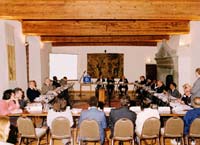
Each year, nearly 80 million people around the world attend a meeting, conference or convention, and even more visit trade shows and exhibitions. Globally, the meetings industry generates about $US280 billion in annual profits. Despite the positive economic contribution, meetings extract a high environmental cost. They consume large quantities of water and energy, and produce copious amounts of waste water, garbage and emissions.
The hotel conference market is highly competitive. Providing a ‘green’ conference facility helps the environment and improves cost-efficiency.
Elements of a Green Conference: Does the facility have …
1. Management
* an environmental policy? This is the first step toward improving efficiency and the bottom line.
* a program in place to minimize, reuse and recycle waste?
* practice energy and water conservation techniques? For example, does the facility recycle water for use in its gardens?
* the staff trained in best environmental practice?
* a procurement program for environmentally preferable cleaning materials, paper, linens, china and other products?
* a procurement policy that sources products locally when possible
2. Accommodations
What in-room initiatives does the facility take, such as:
* offering guests the option of not laundering sheets and towels every day
* providing soap and shampoo in dispensers rather than one-use disposable packaging
* recycling in-room waste
* energy efficient lighting
* bathroom water savers
3. Transport
* consider alternative fuel vehicles to shuttle guests
* provide charging stations at the hotel
* encourage use of mass transportation by providing information and maps
4. Meeting Rooms
* Does the building management system allow conference facilities to be heated and air conditioned separately, so when they are not in use, they are not using energy?
* Are there teleconferencing facilities so that not all delegates have to travel to the conference to take part?
* Are there divided bins for recycling?
* Are the items in delegates folders made from environmentally sensitive materials?
5. Food & Beverages
* Does the facility purchase from local suppliers?
* Does it serve organic food?
* Does it divert waste food to the community?
* Does it compost waste
6. Leisure Activities
* If there is a golf course, is it operated in an environmentally sensitive way?
* Is the facility’s landscaping using native plantings with places for people to rest?
PATA Cuts Waste
To cut back on paper waste, the Pacific Asia Travel Association (PATA) will not offer a general publication and literature distribution service at its annual conference. Senior Director of Events, Sheila Leong says, “This decision is derived from feedback from Conference 2001 where the majority of our delegates felt the results of the distribution service were environmentally unfriendly.” At the 2002 conference to be held in New Delhi in April, PATA’s will provide a special marketing display area for members who want to exhibit their literature. Any that remains will be recycled at the end of the conference. Contact: sheila@pata.th.com
The Fairmont Vancouver Airport, Vancouver, Canada
This hotel was built in 1999 and incorporates several energy efficient features in its design. Energy efficient, triple-glazed windows eliminate airport noise. A glass curtain wall on the exterior reduces internal energy consumption and the penetration of ultraviolet rays and sound.
Each guest room’s lighting and heating is governed by an energy management system that shuts down when the guest leaves the room. When they return, all functions resume at the settings selected by the guest. On check-out, room temperature reverts to a standard setting and the lights are shut off automatically, cutting energy use by 35 percent.
All 42 rooms on the 11th floor are hypo-allergenic or low allergen content at no extra charge. “This is a direct result of increasing guest demand,” says Francis Parkinson, General Manager. “The number of requests for hypo-allergenic pillows, duvets and bedspreads has been increasing.” Filtration systems purify the air and a central vacuum system dramatically reduces dust. Contact: Sarah Good, sarah.good@fairmont.com
Green Conference Planning at Fairmont Hotels & Resorts
Fairmont Hotels & Resorts pioneered the concept of environmentally friendly conference programme in 1998. Originally developed at Chateau Lake Louise, a landmark Canadian icon set within a UNESCO-protected World Heritage Site, the aim was to help meeting organizers hold conferences which produced less waste. Called ‘Eco – meet’, the programme educates and informs delegates about environmental and heritage topics while fulfilling personal and organizational environmental mandates. It comprises four key components:
* Eco-service, which provices disposable- free food and beverage services, 100 percent recycled note pads, biodegradable corn pens, and recycling stations in meeting rooms. Left-over food is donated to food banks.
* Eco-accommodation, including in-room information, recycling bins, optional sheet and towel replacement, energy-efficient lighting, biodegradable soap, recyclable amenities and water saving shower heads and tap aerators.
* Eco-cuisine, providing menus which incorporate local, seasonal, and organically grown foods wherever possible.
* Eco-programming, providing activities and guest speakers to complement the eco-meet experience. This can take the form of a key note address to a full day experience.
So far, Eco-meet has been implemented at six Fairmont properties and is being rolled out on a property-by- property basis throughout the company. Contact: Lyle Thompson: lyle.thompson@fairmont.com
Holding a Green Conference

Published on: March 21, 2002
(Visited 17 times, 1 visits today)